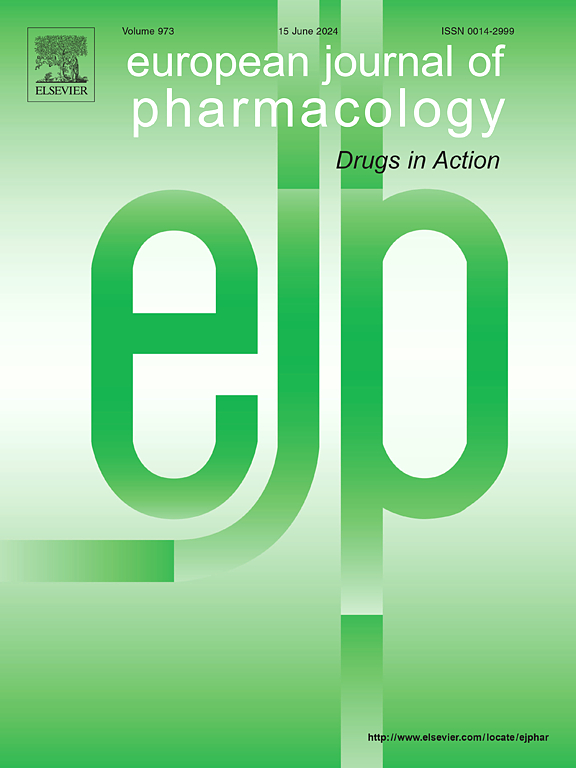硝基喹啉对铜结合型多重耐药大肠杆菌的抑菌效果。
IF 4.2
3区 医学
Q1 PHARMACOLOGY & PHARMACY
引用次数: 0
摘要
半个多世纪以来,硝基喹啉(NIT)已被批准用于治疗非复杂性尿路感染(uti),但其抗菌特性仍不完全清楚。在这里,我们确定了NIT的金属螯合能力与其抗菌活性之间的复杂联系。用紫外-可见光谱法测定金属离子结合特性。生化分析和分子对接研究阐明了潜在的机制。我们发现NIT可以与多种金属离子相互作用,包括Cu2+, Fe2+, Zn2+和Mn2+。Cu2+的加入显著降低了NIT对尿路致病性大肠杆菌(UPEC)菌株J96和耐多药大肠杆菌B2的抑菌效果,最低抑菌浓度(MIC)由8 mg/L提高到64 mg/L。机械上,NIT显著降低了细胞内铜离子水平,降低了细菌跨膜电位。此外,NIT还促进了一氧化氮、过氧亚硝酸盐(ONOO-)和活性氧(ROS)的产生。然而,Cu2+与NIT的相互作用抑制了大肠杆菌中诱导的ROS的产生,而没有抑制ONOO-的产生,这表明NIT的抑菌活性来自于其分子结构中的多个官能团。此外,NIT在增强葡萄糖摄取的同时引发了细胞内酸化,但却矛盾地抑制了ATP的产生,这表明糖酵解通量和氧化磷酸化之间存在潜在的解耦。最后,通过分子对接分析预测了NIT与细胞色素bo(3)泛醇氧化酶的cu -metal氧化还原中心结合的作用。总的来说,这些数据阐明了NIT作为一种有效的铜相关金属抗生素对UPEC的抗菌活性。本文章由计算机程序翻译,如有差异,请以英文原文为准。
The antibacterial efficacy of nitroxoline against multidrug resistant Escherichia coli associated with copper binding
Nitroxoline (NIT) has been approved for the treatment of uncomplicated urinary tract infections (UTIs) for more than half a century, yet its antimicrobial properties remain incompletely understood. Here, we determined the intricate connections between NIT's metal-chelating capabilities and its antibacterial activity. Metal ion binding characteristics were measured by Ultraviolet–visible (UV–vis) spectroscopy. Biochemical assays and molecular docking studies were performed to elucidate the underlying mechanism. We found that NIT could interact with a diverse array of metal ions, including Cu2+, Fe2+, Zn2+ and Mn2+. While, the addition of Cu2+ significantly decreased NIT's antibacterial effect against uropathogenic Escherichia coli (UPEC) strain J96 and multidrug resistant E coli B2, with the minimum inhibitory concentration (MIC) increased from 8 mg/L to 64 mg/L. Mechanically, NIT significantly decreased the intracellular copper ion levels and reduced bacterial transmembrane electrical potential. Furthermore, NIT promoted production of nitric oxide, peroxynitrite (ONOO-), and reactive oxygen species (ROS). However, the interaction of Cu2+ with NIT suppressed the induced generation of ROS but not the generation of ONOO- in E coli, suggesting that the antibacterial activity of NIT arose from multiple functional groups within its molecular structure. Moreover, NIT triggered intracellular acidification concomitant with enhanced glucose uptake, yet paradoxically suppressed ATP generation, suggesting a potential uncoupling between glycolytic flux and oxidative phosphorylation. Finally, the action of NIT was predicted to bind to the CuB-metal redox centers of cytochrome bo(3) ubiquinol oxidase through molecular docking analyses. Collectively, these data illuminate the antibacterial activity of NIT as a potent copper-related metalloantibiotic against UPEC.
求助全文
通过发布文献求助,成功后即可免费获取论文全文。
去求助
来源期刊
CiteScore
9.00
自引率
0.00%
发文量
572
审稿时长
34 days
期刊介绍:
The European Journal of Pharmacology publishes research papers covering all aspects of experimental pharmacology with focus on the mechanism of action of structurally identified compounds affecting biological systems.
The scope includes:
Behavioural pharmacology
Neuropharmacology and analgesia
Cardiovascular pharmacology
Pulmonary, gastrointestinal and urogenital pharmacology
Endocrine pharmacology
Immunopharmacology and inflammation
Molecular and cellular pharmacology
Regenerative pharmacology
Biologicals and biotherapeutics
Translational pharmacology
Nutriceutical pharmacology.

 求助内容:
求助内容: 应助结果提醒方式:
应助结果提醒方式:


